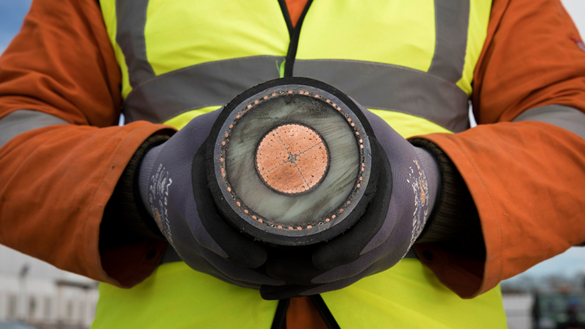
Our lives are powered by electricity; it lets us talk to friends, listen to music, travel to work, cook our meals and so much more. When we flick a switch, the electricity is just… there. But do you ever wonder how that happens?
In our video series ‘Behind the Grid’ we take you behind the scenes of the UK’s electricity system to discover how it all works, from where the electricity is generated right up to where it’s used.
In the series you’ll meet our host James Stewart as he ventures forth into the unknown – join him on his journey ‘Behind the Grid’.

Image: James Stewart (L) visiting the BritNed interconnector site in the Netherlands
Discover the inner workings of our electricity systems
In our four-part documentary series ‘Behind the Grid’, we will lift the curtain to show you:
- the people who make it happen – from monitoring cables under the sea to climbing up 100ft pylons
- how – and why – we share electricity with the Netherlands and other European countries
- the different ways we’re making electricity supplies cleaner and greener
- how we’re making sure there will be enough electricity in the future for what everyone needs
- an exclusive look into our more unique teams and sites, like our helicopter unit and the ‘Power Mountain’ substation
- the upcoming challenges and hurdles with the supply chain for future grid projects.
Episode 1: From Sea to Shore
The Netherlands and many other European countries play an integral role in our electricity grid. Sharing clean energy with our European neighbours through interconnectors is really important for reaching net zero and also helping our resilience and energy security.
Find out what goes on behind the scenes of the remarkable feats of engineering that enable us to share energy with other countries through our interconnectors.
BritNed: our interconnector with the Netherlands
BritNed is an independent joint venture with TenneT, connecting the UK and the Netherlands since 2011.
Interconnectors are high voltage cables that are used to connect the electricity systems of neighbouring countries. They allow us to trade excess power, such as renewable energy created by the sun, wind and water, between different countries.
In addition to BritNed we have interconnectors linking us to France, Belgium, Norway and Denmark, and each year they power millions of homes. By 2030, 90% of the energy imported by our interconnectors will be from zero carbon energy sources.
Future episodes
We will be adding the next three videos in the series, which will be released over the coming months, so make sure you revisit this page … you really don’t want to miss them!
- Episode two will follow electricity from the UK’s shores to our substations and on to our electricity transmission grid.
- In episode three we will find out how electricity then travels on to the lower voltage distribution network, before reaching your homes and businesses.
- Episode four will look at how we’re evolving our electricity systems from old to new and what is needed to ensure our networks are fit for the future; able to carry more clean, secure energy from where it’s generated to where you need it.
More information
What are interconnectors?
An electricity interconnector runs under the sea, underground or via overhead cabling, to connect the electricity systems of two countries. It allows the trading and sharing of surplus electricity.
The next generation interconnector
Interconnectors already provide a way to share electricity between countries safely and reliably. But what if they could do much more than that? What if interconnectors could become an offshore connection hub for green energy?


